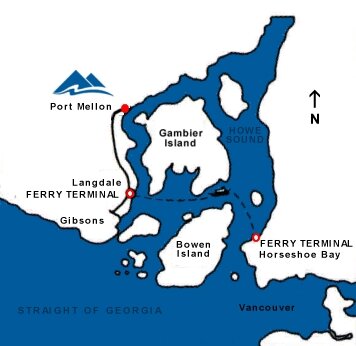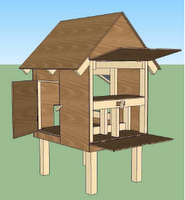If you had a chance to read yesterday’s , you may remember the quote I used from George Orwell’s 1946 Essay — Politics and the English language:
[The] mixture of vagueness and sheer incompetence is the most marked characteristic of modern English prose, and especially of any kind of political writing. As soon as certain topics are raised, the concrete melts into the abstract and no one seems able to think of turns of speech that are not hackneyed: prose consists less and less of words chosen for the sake of their meaning, and more and more of phrases tacked together like the sections of a prefabricated henhouse.
Now to be somewhat fair, I have been plowing through a leaked copy of the 70+ page agreement between logging companies and enviros – . Obviously, at great expense, signatories to the agreement had legal teams sift through these pages and added verbosity, adjectives, blather, bumpf, etc.
So I decided to take a look at the for this agreement. One component that struck me first was noticing all of the corporate logos attached to bottom of the webpage; all neatly linked to the companies web pages – except for the odd dead link.
I began to think…. “Howe Sound Pulp and Paper Limited“? That doesn’t sound like a company that operates in Canada’s Boreal Forest.
That sounds like a company that operates… well… in Howe Sound, which is by Vancouver and Squamish, British Columbia.
A visit to their website… a look at the “where we are” and sure enough:
 There they are operating in Howe Sound. So I wonder how much tenure do they have in Canada’s Boreal Forest?
There they are operating in Howe Sound. So I wonder how much tenure do they have in Canada’s Boreal Forest?
I flip to the back of the 70+ page agreement to “Schedule I” and well… they don’t have any tenures in the Boreal Forest; or at least not in the “caribou deferrals” section.
Oh yea… and they’re owned 50% by Canfor and 50% by Oji Paper of Japan.
_ _ _ _ _
Very curious… so how about “Mercer International” ? I’d not heard of them before.
A visit to their , and: “We conduct our pulp operations through three subsidiaries consisting of large-scale, modern pulp mills: one in British Columbia’s interior, and two in eastern Germany.”
Their only BC operation is in southeastern BC in Castlegar… that’s a little ways from the Canadian Boreal Forest; as is eastern Germany.
_ _ _ _ _
How about “Mill and Timber Products Ltd.”?
A visit to their quickly demonstrates this is a small company not too concerned about their webpage. They
“specialize in Western Red Cedar Products”
Ummm… yeah… for those of you who may not be too familiar with trees. Western Red Cedar most definitely does not grow in Canada’s Boreal Forest.
Great little company… but definitely not operating in Canada’s Boreal Forest… so why are they signatories to the “historic” Canadian Boreal Forest Agreement?
_ _ _ _
How about F.F. Soucy Inc.?
Well this is a curious one. Visit the “” and one finds that this was: ” the first newsprint mill in North America to obtain the ISO standard recognition.” And here’s the curious bit:
Formed in 1963, F.F. Soucy, Inc. and its majority owned subsidiary F.F. Soucy Inc. & Partners, Limited Partnership (formed in 1974 with Dow Jones & Company, Inc. and Rexfor)
Yeah, that’s the Dow Jones & Company that also owns the Wall Street Journal and other significant publications. Rexfor is now the and financial holding corporation of the Quebec government.
However, as I looked at another company signatory to the agreement: White Birch Paper or Papier Masson Ltee as listed on the leaked Agreement — I found that they are headquartered in Greenwich, Connecticut (good Canadian company) and they in fact own the FF Soucy operation.
So why is FF Soucy listed separately from Whitebirch — as a signatory? They appear to be the same company. On the Whitebirch/Papier Masson website it also states: “the first newsprint mill in North America to obtain the ISO standard recognition.”
_ _ _ _ _
How about New Page? I’ve never heard of the organization.
Well, a visit to their website — and apparently one of North America’s “leading” producers of coated papers. They are headquartered in Miamisburg, Ohio… yeah, Ohio.
That’s a long ways from the Canadian Boreal Forest. But… they’re deeply committed to “community”…
_ _ _ _
Fibrek? This logo is on the CBFA webpage, but not listed in the Agreement.
Well, they don’t even have a website. It’s under construction.
However, Fibrek is formerly known as SFK Pulp Fund or SFK Pate as listed in the Agreement, which recently decided to move from an income trust to a corporation (thanks Jim Flaherty, federal Conservatives and your broken election promise on that one…).
_ _ _ _ _
AV Group — the nice logo with three maple leafs on it (on the CBFA website) — well that’s AV Nackawic “fibres from nature” . This is part of the which is based out of India. $29.2 Billion; 130,000 employees, operating in over 25 countries worldwide.
Yeah, that’s another one of those struggling Canadian logging companies in the struggling Canadian forest sector.
(I’m not so sure the Aditya Burla Group is facing too many “unprecedented financial challenges”, or is limited in its ability to “accommodate further constraints” …)
_ _ _ _ _
Daishowa-Marububeni?
I was familiar with this company as my wife and I got married last summer in Peace River, AB and I heard that they operated the pulp mill there.
This is a Japanese company, and they only have about 2.7 million hectares of forest tenure area — small potatoes in the scheme of the Canadian Boreal Forest Agreement.
_ _ _ _ _
And thus, as I asked yesterday, what the [enter active expletive here]?
Why are there companies listed on this agreement that do not appear to have any operations in Canada’s Boreal Forest?
Sure, maybe they get a little bit of wood from there through second, third, fourth-hand distributors — but come on folks… this is not an agreement between 21 forest companies actively logging in the Canadian Boreal Forest.
In fact, if you read through the leaked copy of the Agreement — when it comes to “caribou habitat protection” this is an agreement with 8 logging companies: Canfor (Canfor and Canfor Pulp Fund are basically the same company), Lousiana Pacific although they’ve deferred a whole 539.43 hectares for “caribou action planning” from their small operations, Alberta-Pacific, Tolko, West Fraser (although they didn’t defer any areas for “caribou action planning”), Weyerhaeuser (headquarters in Seattle, WA), Tembec, and Abitibi-Bowater (currently under bankruptcy protection).
And this is actually stated in the agreement:
.
I won’t reproduce Schedule “D” here… however, I only count nine companies.
So I ask WHY?
Why is this agreement celebrated as an “historic” agreement with 21 logging companies?
Orwell in 1946:
All issues are political issues, and politics itself is a mass of lies, evasions, folly, hatred, and schizophrenia.
Thank-you, sir.



I came across this as I was doing research for a law assignment. Its funny because as I was reading through the agreement I came to this same conclusion, why the heck did the other 11 companies sign an agreement that really shouldn’t matter to them either way. I mean why not I suppose cause it shouldn’t really affect them, but why?
The assignment is to look at the legal interests that enable the parties involved to enter into this agreement. Legally, why do these parties have the right to be involved with this. When land management is government regulated? Any thoughts?
thanks for the comment Jen,
gaining market share is essentially the conclusion I’ve drawn. I think you’re on the right track with the comments on land rights and responsibilities — I’ve asked the same question in other posts.
The addition I would make is: aboriginal and treaty rights of the First Nations who have Traditional Territory within the bounds of the agreement. The enviros and logging companies essentially left First Nations out of the discussions. Of course now they’re doing some serious scrambling… Some of the enviros were in Prince George the week before last grovelling about how First Nations could be included now in agreement — well over a year into the 3-year agreement. Seems that that may be coming with funding commitments as well (hearsay at this point).
This would most likely be all that much more offensive for many First Nations with Canada’s commitment to ratify the UN Declaration on the Rights of indigenous people this past Friday. One of the key components of the Declaration is “Free, Prior and Informed Consent”.
Pretty difficult to work from that principle when negotiations are held in secret for a year — with it clearly laid out in the agreements ‘planning’ how First Nations would be included later.
It’s all quite bizarre really. Logging companies are responsible to their shareholders, enviros represent no one in particular (many simply represent corporate funders) — yet Governments give out permits and cutting licenses to logging companies. Governments also have a fiduciary responsibility to First Nations and must ensure that First Nations are adequately consulted on issues that may infringe upon aboriginal or treaty rights.
So what’s the purpose of the agreement?
Marketing.
If you’d like read about a similar process, read up on the Marine Stewardship Council (MSC). It’s modeled (somewhat) on the Forest Stewardship Council eco-labeling — however, with many shortfalls. The difference with the MSC here in BC is that it’s in cahoots with government. In many places of the world, governments actually pay and fund the MSC to “eco-certify” their fisheries: it creates a nice conflict of interest.
The basic premise of the MSC is the same as the Boreal Agreement signatories — marketing and gaining market share.
If it the agreement is simply about altruistic principles then why not do it fully open and transparent? And why have a bunch of signatories that don’t even operate within the Boreal Forest — and probably don’t even utilize wood from the Boreal? And who are enviro organizations to think that they speak on behalf of anyone in particular?
November 20, 2010
Last week, I received a petition to sign for the protection of Canadian caribou – to save the caribou from extiction – the petition was sent to members of Canada’s Parliament. It may have been a Canadian petition – but I think it came through an American Petition website…
Where does the Boreal agreement fit into that problem? I thought it was supposed to protect the Caribou… If there ia a new petition on the go – there must be a newer problem which makes me wonder if the ENGO’s are liable for letting caribou extinction go that far – I mean they signed a legal agreement to protect caribou – didn’t they?
sign me confused